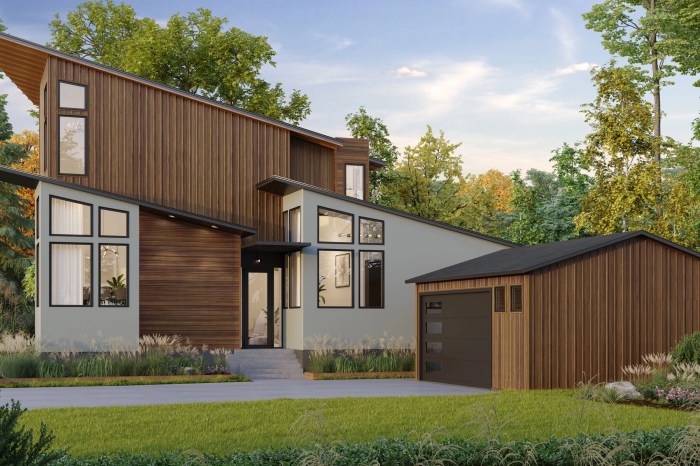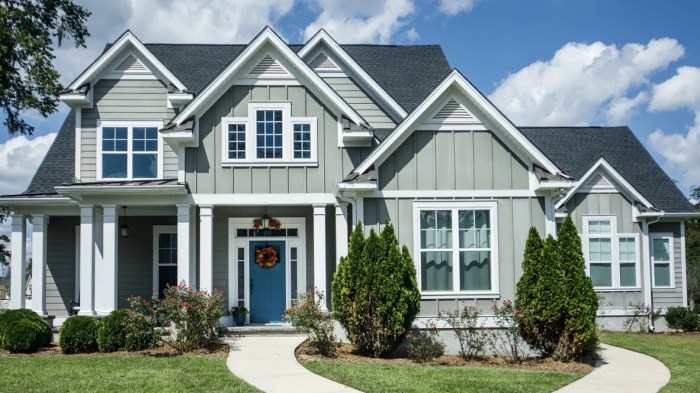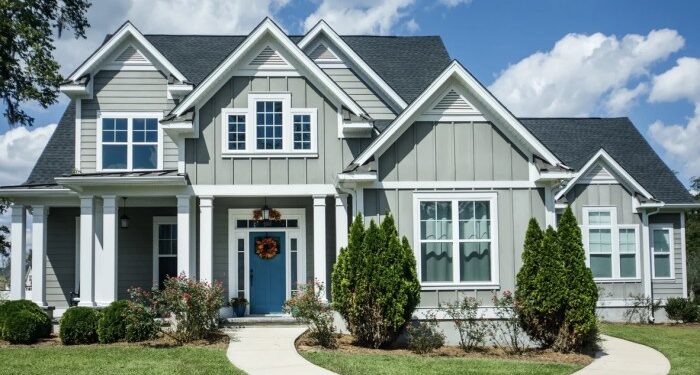Modern siding ideas for contemporary homes set the stage for this enthralling narrative, offering readers a glimpse into a story that is rich in detail and brimming with originality from the outset. From exploring various types of siding materials to discussing color trends and sustainable options, this guide covers all aspects of modern siding for contemporary residences.
Types of Modern Siding
When it comes to modern siding options for contemporary homes, there are several materials to choose from, each with its own unique characteristics and benefits. Let's explore some of the most popular choices:
1. Vinyl Siding
Vinyl siding is a cost-effective and low-maintenance option that comes in a variety of colors and styles. It is easy to clean and resistant to rot and pests, making it a durable choice for many homeowners. However, extreme temperatures can cause vinyl siding to warp or crack over time.
2. Fiber Cement Siding
Fiber cement siding is a versatile option that can mimic the look of wood, stucco, or masonry. It is highly durable, resistant to fire and pests, and requires minimal maintenance. On the downside, fiber cement siding can be more expensive than other options.
3. Metal Siding
Metal siding, such as aluminum or steel, offers a sleek and modern look to contemporary homes. It is durable, weather-resistant, and can be easily recycled. However, metal siding may dent or scratch easily, requiring occasional maintenance.
4. Wood Siding
Wood siding provides a natural and timeless appeal to modern homes. It can be painted or stained in various colors and finishes. While wood siding is environmentally friendly and aesthetically pleasing, it requires regular maintenance to prevent rot, mold, and insect damage.
5. Engineered Wood Siding
Engineered wood siding is a blend of wood fibers and other materials, offering the look of real wood with added durability and stability. It is resistant to rot, pests, and moisture, making it a low-maintenance alternative to traditional wood siding.
However, engineered wood siding may be more costly upfront.Consider the architectural style of your home, your budget, and the level of maintenance you are willing to commit to when choosing the right siding material for your contemporary home.
Color Trends in Modern Siding
When it comes to modern siding for contemporary homes, color choices play a crucial role in defining the overall aesthetic of the house. Let's explore some popular color trends and how they can impact the look of a home.
Neutral Tones with a Pop of Color
Neutral tones like grey, beige, and white are often used for modern siding as they provide a clean and minimalist look. To add a bit of interest, consider adding a pop of color such as a bold blue or red as an accent.
This combination creates a modern and eye-catching facade while maintaining a sleek appearance.
Monochromatic Color Schemes
Monochromatic color schemes, where different shades of the same color are used, are another popular choice for modern siding. For example, varying shades of grey or blue can create a sophisticated and cohesive look. This approach adds depth and visual interest to the exterior of the home.
Contrasting Colors
Contrasting colors can also make a bold statement when it comes to modern siding. Pairing dark shades like charcoal or navy with lighter tones such as white or cream creates a striking visual impact. This high-contrast look can add a modern and dynamic feel to the overall design of the house.
Earthy and Natural Tones
For a more organic and contemporary feel, consider using earthy and natural tones for modern siding. Colors like olive green, terracotta, or warm browns can create a harmonious connection with the surrounding landscape. This color palette evokes a sense of serenity and modernity in the home's exterior design.
Textures and Finishes
When it comes to modern siding for contemporary homes, textures and finishes play a crucial role in enhancing the overall look and feel of the exterior. Different textures and finishes can add depth, visual interest, and a touch of sophistication to a home's facade.
Textured Siding
- Wood Grain: Textured siding with a wood grain finish mimics the look of natural wood, adding warmth and character to the exterior of a home.
- Stone Texture: Siding with a stone texture finish provides a high-end, luxurious look, giving the home a modern and stylish appearance.
- Brick Pattern: Brick patterned siding offers a classic and timeless aesthetic, perfect for achieving a traditional yet contemporary look.
Finished Finishes
- Matte Finish: A matte finish gives siding a sleek, modern appearance while minimizing the reflection of light, creating a subtle and sophisticated look.
- Glossy Finish: A glossy finish adds shine and polish to the siding, reflecting light and making the exterior pop, ideal for a more contemporary and vibrant style.
- Textured Finish: Textured finishes provide depth and dimension to the siding, creating visual interest and a unique look that stands out.
Sustainable Siding Options

When it comes to sustainable siding options for contemporary homes, there are several eco-friendly materials available that not only enhance the aesthetics of the house but also contribute positively to the environment. Choosing sustainable siding is a great way to reduce your carbon footprint and promote a healthier planet.
Eco-Friendly Siding Materials
There are a variety of eco-friendly siding materials that are suitable for contemporary homes, such as:
- 1. Reclaimed Wood: Using reclaimed wood siding not only adds a unique and rustic charm to your home but also helps in reducing deforestation.
- 2. Fiber Cement: Made from a combination of cement, sand, and cellulose fibers, fiber cement siding is durable, low maintenance, and resistant to fire and insects.
- 3. Recycled Metal: Metal siding made from recycled materials is a sustainable option that is long-lasting and recyclable at the end of its lifespan.
Environmental Benefits
Opting for sustainable siding options provides several environmental benefits, including:
- 1. Reduced Carbon Footprint: Eco-friendly materials require less energy to manufacture and produce fewer greenhouse gas emissions.
- 2. Preservation of Natural Resources: By using recycled or reclaimed materials, you help conserve natural resources and reduce waste.
- 3. Improved Indoor Air Quality: Some sustainable siding options are free from harmful chemicals and volatile organic compounds (VOCs), promoting healthier indoor air quality.
Innovative Sustainable Siding Products
There are innovative sustainable siding products available in the market that combine eco-friendliness with modern design. Some examples include:
- 1. Bio-Based Polyurethane: Siding made from bio-based polyurethane offers a sustainable alternative to traditional materials, with high durability and versatility.
- 2. Cork Siding: Cork is a renewable resource that provides excellent insulation and sound absorption properties, making it an attractive sustainable siding option.
- 3. Bamboo Siding: Bamboo is a fast-growing plant that can be harvested sustainably, making it an eco-friendly choice for siding that is both durable and stylish.
Wrap-Up

In conclusion, modern siding offers a plethora of options for homeowners looking to enhance the aesthetic appeal and functionality of their contemporary homes. With a focus on sustainability, style, and durability, choosing the right siding can truly transform the look of any modern residence.
Essential Questionnaire
What are the most popular types of modern siding materials?
Popular modern siding materials include fiber cement, vinyl, and metal, each offering unique benefits in terms of durability and aesthetics.
How do color choices impact the overall look of a contemporary home?
Color choices can greatly influence the modern aesthetic of a home, with bold and contrasting colors often used to create a striking visual impact.
Are there sustainable siding options available for contemporary homes?
Yes, eco-friendly siding materials like reclaimed wood, recycled metal, and composite materials are excellent choices for those looking to reduce their environmental footprint.



